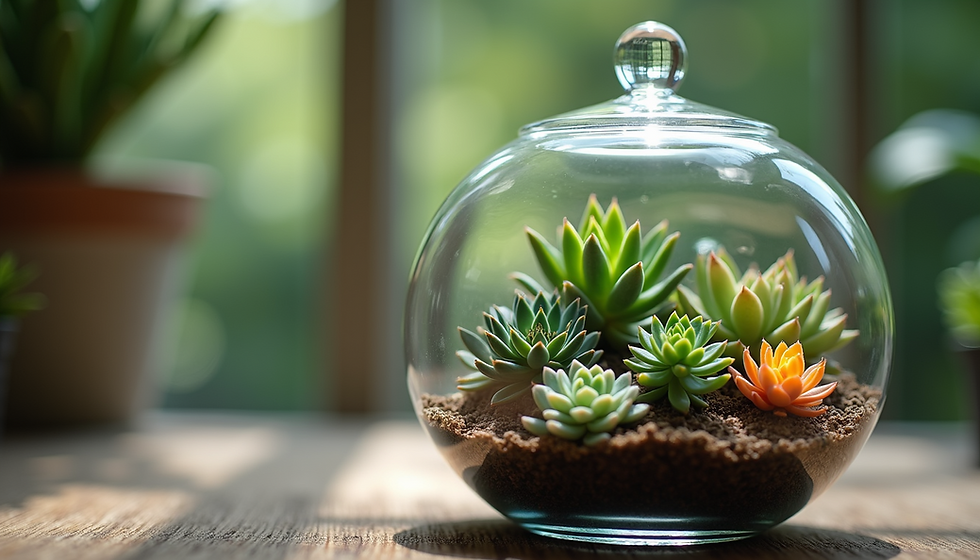Explore the Diverse Types of Succulent Plants
- Elevated Succulents

- Sep 29
- 4 min read
Succulents have become a favorite choice for adding a touch of green to homes, offices, and events. Their unique shapes, colors, and easy care make them perfect for almost any setting. If you are curious about the different kinds of succulents and want to find the perfect one for your space, you’re in the right place. Let’s dive into the world of succulents and explore some popular succulent varieties that you can enjoy.
Discover Popular Succulent Varieties for Your Space
Succulents come in many shapes and sizes, each with its own charm. Some have thick, fleshy leaves, while others grow in rosettes or trailing vines. Here are a few popular succulent varieties that are easy to find and care for:
Echeveria: These rosette-shaped succulents are often colorful and come in shades of green, pink, and purple. They thrive in bright light and need minimal watering.
Aloe Vera: Known for its medicinal properties, Aloe Vera has thick, spiky leaves. It prefers indirect sunlight and occasional watering.
Jade Plant (Crassula ovata): This plant has thick, oval leaves and can grow into a small tree. It’s perfect for indoor spaces with bright light.
Haworthia: Small and slow-growing, Haworthia has striped or spotted leaves. It does well in low light and is very low maintenance.
Sedum: These come in many varieties, from ground covers to upright plants. Sedums are hardy and can tolerate drought well.
Each of these varieties brings something special to your home or office. You can mix and match them to create a beautiful, low-maintenance display.

Colorful Echeveria rosette succulent adds charm to any space
How do I know what kind of succulent I have?
Identifying your succulent can be fun and rewarding. Here are some simple steps to help you figure out what kind of succulent you have:
Look at the shape of the leaves: Are they round, pointed, thick, or thin? Some succulents have smooth leaves, while others have spines or bumps.
Check the growth pattern: Does your plant grow in a rosette, trail, or upright form? This can narrow down the possibilities.
Observe the color: Succulents come in many colors, from green to blue, red, and even purple. Color can change depending on light and temperature.
Note the size: Some succulents stay small, while others can grow quite large.
Use online resources: Websites and apps can help you match your plant’s features to known types.
If you want to explore more about different succulent plant types, there are great guides online that show pictures and descriptions to help you identify your plant.

Variety of succulents in small pots showing different leaf shapes and colors
Caring for Your Succulents: Tips for Success
Once you know what kind of succulent you have, caring for it becomes easier. Here are some practical tips to keep your plants healthy and thriving:
Light: Most succulents love bright, indirect sunlight. A south-facing window is often ideal. Avoid harsh direct sun that can burn the leaves.
Watering: Succulents store water in their leaves, so they don’t need frequent watering. Water only when the soil is dry. Overwatering can cause root rot.
Soil: Use well-draining soil designed for succulents or cacti. This helps prevent water from sitting around the roots.
Containers: Pots with drainage holes are best. They allow excess water to escape.
Temperature: Succulents prefer warm temperatures but can tolerate cooler nights. Avoid frost and freezing conditions.
Fertilizing: Feed your succulents lightly during the growing season with a balanced, diluted fertilizer.
By following these simple steps, you can enjoy your succulents for years to come.

Succulent planted in terracotta pot with well-draining soil for healthy growth
Unique and Rare Succulents to Consider
If you want to go beyond the common varieties, there are many unique and rare succulents that can make a statement. These plants often have unusual shapes, colors, or growth habits:
Lithops (Living Stones): These small succulents look like stones or pebbles. They are perfect for tiny spaces and add a quirky touch.
String of Pearls (Senecio rowleyanus): This trailing succulent has small, bead-like leaves that look like pearls on a string. It’s great for hanging baskets.
Graptopetalum: Known for their star-shaped rosettes and pastel colors, these succulents are eye-catching and easy to grow.
Pachyphytum: These have plump, rounded leaves that look like little jelly beans. They come in soft colors like blue and pink.
Aeonium: These succulents have large rosettes and can grow tall. They often have dark purple or green leaves.
Adding rare succulents to your collection can create a unique display that stands out. Just remember to check their care needs, as some may require more attention than common types.
Bringing Succulents into Your Home, Office, or Event
Succulents are incredibly versatile. They brighten up any space and require little maintenance. Here are some ideas for using succulents in different settings:
Home: Place succulents on windowsills, shelves, or coffee tables. Use decorative pots to match your style.
Office: Small succulents can fit on desks or in meeting rooms. They improve air quality and add a calming touch.
Events: Succulents make great centerpieces or party favors. They can be arranged in creative ways to match the event theme.
When choosing succulents for these spaces, consider the light and temperature conditions. Mixing different varieties can create interesting textures and colors.
Succulents are a wonderful way to bring nature indoors. Whether you want a few plants or a full collection, there’s a succulent for every taste and space.
I hope this guide helps you explore the fascinating world of succulents. If you want to learn more about different succulent plant types, check out the resources available online. Happy planting!
_edited_edited_edite.png)



Comments